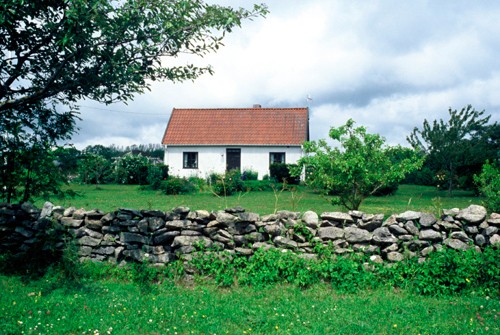
Andreas Gedin, Gotlandshus, 2004-2005 © Andreas Gedin
The 1st at Moderna: Andreas Gedin
Retake of an old house
1.7 2006 – 3.9 2006
Stockholm
By bending the rules, they managed to influence the designing of new buildings in order to adapt them to traditional housing, an adaptation which meant that one started to build Gotland Houses. The Gotland House is a modernised version of a type of building that was common in parts of Gotland in the 18th and 19th centuries. Today, one may regard the Gotland House as an expression of 1970s architecture, even though it is commonly perceived as “authentic” or “traditional”. Driving in Gotland today, one is struck by an odd sensation of déjà-vu, seeing the same type of building everywhere.
Central governing and decrees from the authorities as to the definition of “good taste” may be problematic in the context of the history of the Gotland House. Andreas Gedin’s reaction, however, is not a knee-jerk protest but rather an investigation driven by curiosity. What does it mean when something becomes the object of quotations, repetitions and retakes? Can one construct or designate something – a type of architecture, for example – as being more authentic than others? What happens to people who travel in the countryside and see the same kind of building over and over? Andreas Gedin’s work makes use of the Gotland House as a starting-point for discussing these larger issues.
Andreas Gedin has toured Gotland with his camera, documenting the distribution of Gotland Houses. His photographs are presented as a slide show, accompanied by a voice-over reading a text that deals with repetition, copying, origin, identity and related subjects, from different angles and more often than not with an anecdotal character. Taken together, they lead one’s thoughts to a third form: Educational lectures with slide shows that were common at school, at least in the 1970s. If the slides explore the phenomenon from a visual and aesthetic point of view, the text provides the work with depth by not referring to the building type. Instead, it takes its point of departure in the fundamental, human experience of repetition and retakes, and in an essentially existential and linguistic philosophical complex of problems concerning originals and copies, authenticity versus simulation.
Integral to the work are the three lectures that will take place at Moderna Museet’s cinema on August 16. From their respective fields of expertise, the invited lecturers will shed light on the meaning of retakes and repetitions. Within performance art, lectures have become something of a genre in its own right; artists such as Olav Westphalen and Andrea Fraser spring to mind. However, the lectures that Andreas Gedin has commissioned for his project are not typical performances but rather a form of speculative, conceptual education, perhaps even art education – while, at the same time, being a part of his work. The lectures provide many perspectives on a set of problems. Art is one of them – an approach and a discipline that can include others. One could say that the lectures are curated by the artist. The knowledge of the experts functions as a kind of installed ready-mades while retaining their intrinsic value.
Words, writing and texts recur in many of Andreas Gedin’s works. He can be described as a conceptual artist, one of the few Sweden has to offer. In his previous projects, he has worked with related issues. In the video Gemini, a pair of twins read a text as if they were one person. On the left hand side of the screen, the first twin reads the first part of the word, closely followed by the second twin on the right hand side of screen who reads the second part of the word. The speech becomes difficult to comprehend; language becomes flesh and turns opaque. The project Taking Over is grounded in maps and walks. By outlining his city walks on maps, letters are formed, eventually creating words and meanings: “Taking over, bit by bit, piece by piece, more and more, step by step”. By walking the streets, Gedin takes possession of them and incorporates them into his work – a physical act is thus translated by the symbolic language of maps into language and meaning. Every phrase becomes the starting-point for an exhibition exploring the theme of power. “More and More”, for example, was presented at Liljevalchs Konsthall, Stockholm, where the text was planted as grape hyacinths in the lawn outside the gallery. The flowers blossom every year, proliferate and spread until the text is dissolved.
Andreas Gedin’s exploration of issues of cultural particularity, of the creation of an image of something authentic – something from Gotland, in this instance – is perhaps especially poignant in 2006 which is the year of cultural diversity in Sweden.
On Retakes
Three talks relating to the exhibition.
16 August, 6 pm in the Cinema
Language: Swedish
Lecturers:
Willy Berggren, trainer for elite runners
Anna Gerge, licensed psychotherapist, Kris och Traumacenter
Björn Runge, film director, directed Mun mot mun and Om jag vänder mig om
The 1st at Moderna is an exhibition programme for contemporary art. The opening is always on the first day of the month, and the exhibitions are in different venues in or outside the museum.
